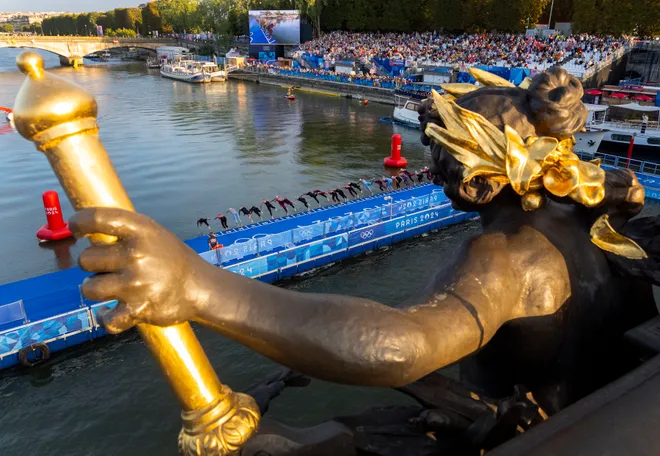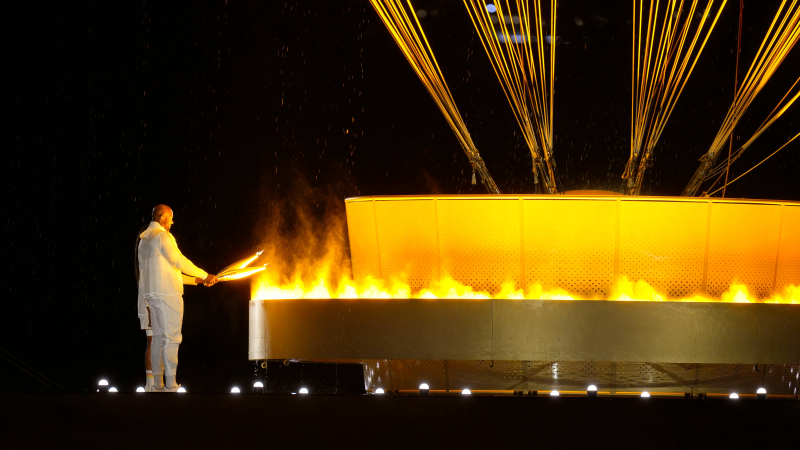Paris has beautifully meshed Olympics with city, shining new light on iconic spaces
PARIS – Ange-Jacques Gabriel lived for 83 years, born here during the reign of Louis XIV and departing this Earth with France in the midst of so much economic and social crisis that revolution would only be a handful of years away.
The son and grandson of prominent architects, Gabriel followed them into the family business. He’s responsible, in no small part, for why Paris looks the way it does today. Among the projects he designed were one of the famous gardens at the Palace of Versailles, the historic L’Ecole Militaire and the Place de la Concorde, the 19-acre public plaza that sits at the center of the city and punctuates Paris as one of the grandest urban centers in the world.
It is here, at the very spot where Gabriel envisioned a monument to Louix XV, where I have watched skateboarders glide over rails, basketball players make fadeaway jumpers and BMX cyclists fly through the air while the Luxor Obelisk looms over four makeshift sporting venues and the Eiffel Tower sits in the distance.
Gabriel would not have known about the Olympic Games; he died more than 100 years before they debuted in 1896. But I will go home thinking, hoping, that he would have been proud.
Because the city that Gabriel and architects like Jules Hardouin-Mansart, Charles Garnier, Jean Chalgrin and Gustave Eiffel made one of the world’s most beautiful has shined in an entirely new light during the Paris Games.
In some ways, it’s never looked better. And it has provided a tableau for an Olympics that may be impossible to completely replicate anywhere else in the world.
But it’s a template that every Olympic city should strive for.

For decades and decades, hosting an Olympics meant spending billions – most of it public money – on new facilities that are sold to taxpayers as so-called legacy projects. Often, those promises are either met with a reality that doesn’t match the sales pitch or abandoned completely.
There are too many white elephants that were built in the name of hosting an Olympics.
Paris’ approach was different. I had heard all along that instead of building a bunch of arenas on the outskirts of town like you see in most Olympic cities that will eventually be used for other purposes, the plan was to integrate venues for the Games into the existing structure of this sprawling metropolis. To, essentially, use what was already great and renowned about Paris – its architecture and iconic spaces – as the backdrop for the greatest sporting event in the world.
It's been the best part of the Olympics.
The grandeur of it all has been most obvious to television viewers with beach volleyball, played in a temporary stadium constructed directly under the Eiffel Tower.
It’s the iconic frame of these Games, but there has been so much more to marvel at in a city briefly transformed almost beyond recognition.
On the morning of the individual triathlon, which had been delayed because of water quality issues, I woke up preparing to make fun of France’s 1.4 billion-euro plan to clean up the Seine after 100 years for this event. There were indeed some easy jokes to be found in the idea that some of the world’s greatest athletes were swimming in a century’s worth of Parisian fecal matter, but that admittedly didn’t do justice to the experience.
At 8 a.m. that morning, I took a seat in stands that had been constructed on the Pont Alexandre bridge. I looked to my left and saw the dome of Les Invalides, built 350 years ago as a military hospital and now a museum where Napoleon is buried. To my right was the Grand Palais. I’ve never been more awed by the beauty of a sporting venue.
Inside the Grand Palais, fencing and later taekwondo competitions took place under its glass atrium roof. The park surrounding Les Invalides was transformed into an archery venue. A half-hour away, the Versailles Palace was the background for an equestrian venue that seemed as natural and noble as the sport itself. Even Roland Garros, one of the most famous tennis facilities in the world, became an electric, 15,000-seat boxing venue during the second week.

Of course, some sports like swimming and gymnastics and the basketball medal rounds were contested in generic arenas in the outlying areas of Paris. But never has an Olympics so seamlessly meshed sports with the architecture, culture and history that French people have been proud of for hundreds of years. At a time when cities are more hesitant to host an Olympics because of how much wasteful spending is often necessary to build infrastructure, Paris showed it can be done without being a multi-billion-dollar boondoggle.
It didn’t happen entirely free of controversy. There were federal investigations into the awarding of some contracts, the long-term value of cleaning up the Seine may not materialize as politicians had hoped and many Paris citizens grumbled about the world taking over their city for a month. Many of them packed up and left town: I’ve been to this densely-populated metropolitan area of 11 million several times before, and it has never felt this empty and easy to move around.
But after two COVID-tainted Olympics in Asia that had no atmosphere, no fans and little joy, the Games didn’t just return to form in Paris – they set a standard that will be incredibly difficult to match. Every stadium was full, bars and restaurants were buzzing well past midnight and nearly every one of these makeshift venues had a French flair that showed the best of this remarkable city to the world.
Of course, there’s only one Paris.
Los Angeles has its own energy and mystique, and Brisbane in 2032 will be set against the sandy beaches of Australia’s Gold Coast. Hopefully they’ll find a way to retain that same feeling of an Olympics truly being part of a world-class city.
But the roots of this visually stunning Olympics were planted hundreds of years ago by visionaries, artists and architects who could have never imagined this modern world. Paris should be praised – and thanked – for bringing their work to life in an entirely different way.
Disclaimer: The copyright of this article belongs to the original author. Reposting this article is solely for the purpose of information dissemination and does not constitute any investment advice. If there is any infringement, please contact us immediately. We will make corrections or deletions as necessary. Thank you.







